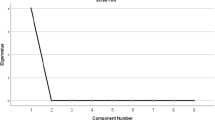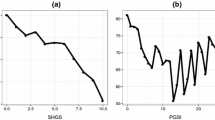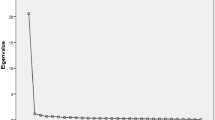Abstract
The Inventory of Gambling Situations (IGS-63; Turner and Littman-Sharp, Inventory of gambling situations users guide, 2006) is a 63-item measure of high-risk gambling situations. It assesses gambling across 10 situational subscales that load onto two higher-order factors: negative and positive situations (Stewart et al. Psychology of Addictive Behaviors, 22:257–268, 2008). While the IGS-63 has excellent psychometric properties (Littman-Sharp et al., The Inventory of Gambling Situations: Reliability, factor structure, and validity (IGS Technical Manual), in press) its length may preclude its use in time-limited contexts. The purpose of this study was to develop and validate a 10-item short-form of the IGS (IGS-10). Each IGS-10 item reflects one of the ten subscale categories from the IGS-63, with two items from the original subscales included as examples for each IGS-10 item. The IGS-10 was administered to 180 undergraduate gamblers along with the IGS-63 and the Problem Gambling Severity Index (PGSI; Ferris and Wynne, Canadian Problem Gambling Index: Final report, 2001). IGS-10 items showed convergent validity with the corresponding IGS-63 subscales (r’s = .60–.73). Principal components analysis of the IGS-10 revealed two factors: negative (α = .84) and positive (α = .85). PGSI scores correlated significantly with all IGS-10 items (r’s = .33–.58) and with both IGS-10 higher-order subscales (r’s = .66 [negative] and .49 [positive]), supporting the criterion validity of the IGS-10. Since minimal information is lost when using the IGS-10, the short form may prove particularly useful when respondent burden prevents using the full IGS-63.
Similar content being viewed by others
Notes
IGS-63 subscales rather than the raw item scores were used in this analysis for three reasons: (1) to be consistent with previous literature examining the higher-order factor structure of the IGS (e.g., Stewart et al. 2008); (2) there was not a large enough sample size (n = 180) to examine factor structure at the item level (63 items); and (3) we were interested in the direct comparison of the structure of the IGS-10 items with the structure of their corresponding IGS-63 subscales.
Using the more stringent parallel analyses (Horn 1965; Longman et al. 1989), there was significant support for retaining two factors in the PCA of the IGS-10. This was determined by comparing the obtained eigenvalues to both the mean eigenvalue and the 95th percentile eigenvalue cut-offs. For the IGS-63, parallel analysis provided marginal support for retaining two factors, but only when comparing obtained eigenvalues with the less stringent mean eigenvalue cut-off.
Factor loadings >1 are only inadmissible when the residual variance is also negative. However, a high factor loading (>1) that is accompanied by a positive residual variance is acceptable, and simply reflects a very strong loading on the given factor (Joreskog 1999). The residuals in the present model were examined in MPlus version 3.01 (Muthén and Muthén 2004) using exploratory factor analysis with Maximum Likelihood. A negative variance was not found; thus, the solution was deemed admissible and the item was concluded to have a strong loading on this factor.
References
American Psychiatric Association. (1994). Diagnostic and statistical manual of mental disorders, Forth edition—revised (DSM-IV-R). Washington, DC: Author.
American Psychiatric Association. (2000). Diagnostic and Statistical Manual of Mental Disorders, 4th Edition, Text Revision (DSM-IV-TR). Washington, DC: American Psychiatric Association.
Annis, H. M., Graham, J., & Davis, C. (1987). Inventory of drinking situations users guide. Toronto, ON: Addiction Research Foundation.
Babad, E., & Katz, Y. (1991). Wishful thinking-against all odds. Journal of Applied Social Psychology, 21, 1921–1938.
Breslin, F. C., Sobell, L. C., Sobell, M. B., & Agrawal, S. (2000). A comparison of a brief and long version of the Situational Confidence Questionnaire. Behaviour Research and Therapy, 38, 1211–1220.
Cooper, M. L. (1994). Motivations for alcohol use among adolescents: Development and validation of a four-factor model. Psychological Assessment, 6, 117–128.
Ferris, J., & Wynne, H. (2001). Canadian Problem Gambling Index: Final report. Toronto, ON: Centre for Addiction and Mental Health.
Grant, V. V., Stewart, S. H., O’Connor, R. M., Blackwell, E., & Conrod, P. J. (2007). Psychometric evaluation of the five-factor Modified Drinking Motives Questionnaire—Revised in undergraduates. Addictive Behaviors, 32, 2611–2632.
Horn, J. L. (1965). A rationale and test for the number of factors in factor analysis. Psychometrika, 30, 179–185.
Hunter, R. (1990). Problem gambling in a gambling town: The experience of Las Vegas. In Proceedings from the eighth international conference on risk and gambling (pp. 156–179). London, UK.
Joreskog, K. M., Scientific Software International Inc. (1999, June). How large can a standardized coefficient be? Retrieved April 5, 2009, from http://www.ssicentral.com/lisrel/techdocs/HowLargeCanaStandardizedCoefficientbe.pdf.
Littman-Sharp, N., & Turner, N. (2001). Inventory of Gambling Situations: Validation data on an instrument which identifies areas of risk for relapse. Paper presented at the National Council on Gambling conference, Seattle, WA, April.
Littman-Sharp, N., Turner, N., Stripe, T., Toneatto, T., & Liu, E. (in press). The Inventory of Gambling Situations: Reliability, factor structure, and validity (IGS Technical Manual). Toronto, ON: Centre for Addiction and Mental Health.
Longman, R. S., Cota, A. A., Holden, R. R., & Frekken, G. C. (1989). A regression equation for the parallel analysis criterion in principal components analysis: Mean and 95th percentile eigenvalues. Multivariate Behavioral Research, 24, 59–69.
MacSwain, K. L. H., Sherry, S. B., Stewart, S. H., Watt, M. C., & Hadjistavropoulos, H. D. (2009). Gender differences in health anxiety: An investigation of the interpersonal model of health anxiety. Personality and Individual Differences, 47, 938–943.
Marlatt, G. A., & Gordon, J. R. (1985). Relapse prevention: Maintenance strategies in the treatment of addictive behaviour. New York: Guilford Press.
Muthén, L. K., & Muthén, B. O. (2004). Mplus v3.01. Los Angeles, CA: Muthén & Muthén.
Sobell, L. C., Cunningham, J. A., Sobell, M. B., & Agrawal, S. (1996). Fostering self-change among problem drinkers: A proactive community intervention. Addictive Behaviors, 21, 817–833.
Stewart, S. H., & Zack, M. (2008). Development and psychometric evaluation of a three-dimensional Gambling Motives Questionnaire. Addiction, 103, 1110–1117.
Stewart, S. H., Zack, M., Collins, P., Klein, R. M., & Fragopoulos, F. (2008). Subtyping pathological gamblers on the basis of affective motivations for gambling: Relations to gambling problems, drinking problems, and affective motivations for drinking. Psychology of Addictive Behaviors, 22(2), 257–268.
Stuart, S., Stewart, S., Wall, A.-M., & Katz, J. (2008). Gambling among university undergraduate students: An investigation of gambler subtypes varying in affective motivations for gambling. In M. J. Esposito (Ed.), Psychology of gambling (pp. 83–110). Hauppauge, NY: Nova Science Publishers.
Tiffany, S. T., & Drobes, D. J. (1991). The development and initial validation of a questionnaire on smoking urges. British Journal of Addictions, 84, 1467–1476.
Turner, N., & Littman-Sharp, N. (2006). Inventory of gambling situations users guide. Toronto, ON: Centre for Addictions and Mental Health.
Walker, M. B. (1985). Explanations for gambling. In G. T. Caldwell, M. G. Dickerson, B. Haig, & L. Sylvan (Eds.), Gambling in Australia (pp. 230–255). Sydney, Australia: Croom Helm.
Author information
Authors and Affiliations
Corresponding author
Appendix A
Appendix A
Inventory of Gambling Situations—Short Form (IGS-10)
Each of the following represents a type of circumstance where some people gamble heavily. By “heavily” we mean whatever YOU consider a large amount of money. Please indicate how often, in the past year, you gambled heavily in each of the following types of circumstances.
-
1.
In the past year, I gambled HEAVILY in situations involving difficulties with other people (e.g., When I had an argument with a friend or when there were fights at home.)
In this type of situation, I gambled HEAVILY…
-
a.
never
-
b.
rarely
-
c.
frequently
-
d.
always
-
a.
-
2.
In the past year, I gambled HEAVILY in situations where I was worried about debt (e.g., When people were pressuring me to come up with money or when I was worried about my debts.)
In this type of situation, I gambled HEAVILY…
-
a.
never
-
b.
rarely
-
c.
frequently
-
d.
always
-
a.
-
3.
In the past year, I gambled HEAVILY in situations involving unpleasant or sad or bad feelings (e.g., When I was depressed or when I felt bad about myself.)
In this type of situation, I gambled HEAVILY…
-
a.
never
-
b.
rarely
-
c.
frequently
-
d.
always
-
a.
-
4.
In the past year, I gambled HEAVILY in situations involving testing my control over my gambling (e.g., When I wanted to prove that I could make a few bets without going too far or when I decided to try to limit my gambling.)
In this type of situation, I gambled HEAVILY…
-
a.
never
-
b.
rarely
-
c.
frequently
-
d.
always
-
a.
-
5.
In the past year, I gambled HEAVILY in situations involving temptations to gamble (e.g., When I had money in my pocket or when I saw something that reminded me of gambling.)
In this type of situation, I gambled HEAVILY…
-
a.
never
-
b.
rarely
-
c.
frequently
-
d.
always
-
a.
-
6.
In the past year, I gambled HEAVILY in situations where I was under social pressure to gamble (e.g., When someone encouraged me to bet or when people around me expected me to gamble.)
In this type of situation, I gambled HEAVILY…
-
a.
never
-
b.
rarely
-
c.
frequently
-
d.
always
-
a.
-
7.
In the past year, I gambled HEAVILY in situations where I was feeling confident about my skills (e.g., When I felt confident about my gambling skills or when I felt I could profit from careful gambling.)
In this type of situation, I gambled HEAVILY…
-
a.
never
-
b.
rarely
-
c.
frequently
-
d.
always
-
a.
-
8.
In the past year, I gambled HEAVILY in situations where I was winning (e.g., When I was winning and wanted to keep on winning or when I almost won and felt that I could win very soon.)
In this type of situation, I gambled HEAVILY…
-
a.
never
-
b.
rarely
-
c.
frequently
-
d.
always
-
a.
-
9.
In the past year, I gambled HEAVILY in situations involving pleasant or happy or good feelings (e.g., When I wanted to celebrate or when everything was going well.)
In this type of situation, I gambled HEAVILY…
-
a.
never
-
b.
rarely
-
c.
frequently
-
d.
always
-
a.
-
10.
In the past year, I gambled HEAVILY in situations where I was experiencing a need for excitement (e.g., When I felt like taking a risk or when everyday life seemed boring.)
In this type of situation, I gambled HEAVILY…
-
a.
never
-
b.
rarely
-
c.
frequently
-
d.
always
-
a.
Rights and permissions
About this article
Cite this article
Smith, C., Stewart, S.H., O’Connor, R.M. et al. Development and Psychometric Evaluation of a 10-Item Short Form Inventory of Gambling Situations. J Gambl Stud 27, 115–128 (2011). https://doi.org/10.1007/s10899-010-9192-2
Published:
Issue Date:
DOI: https://doi.org/10.1007/s10899-010-9192-2




